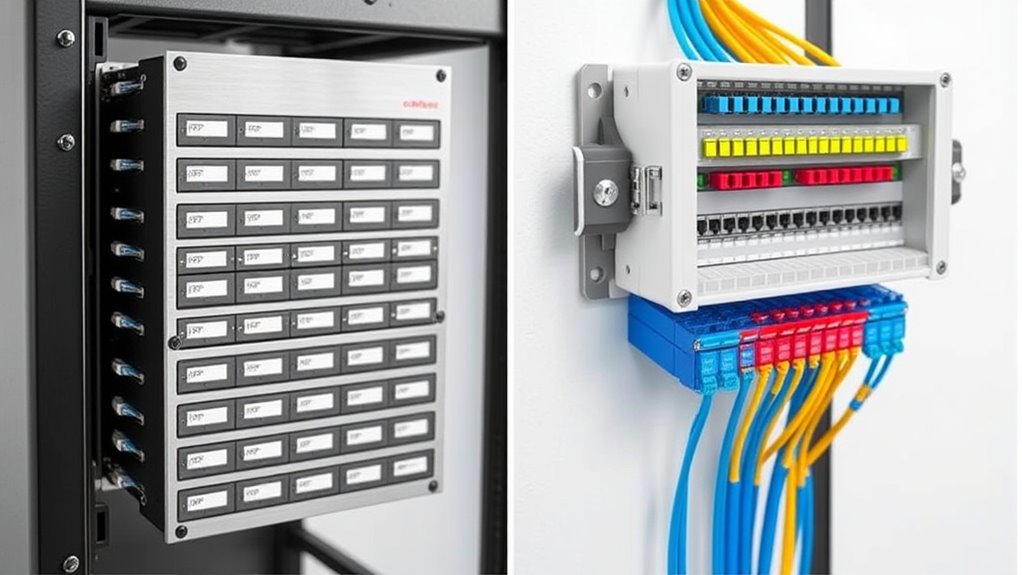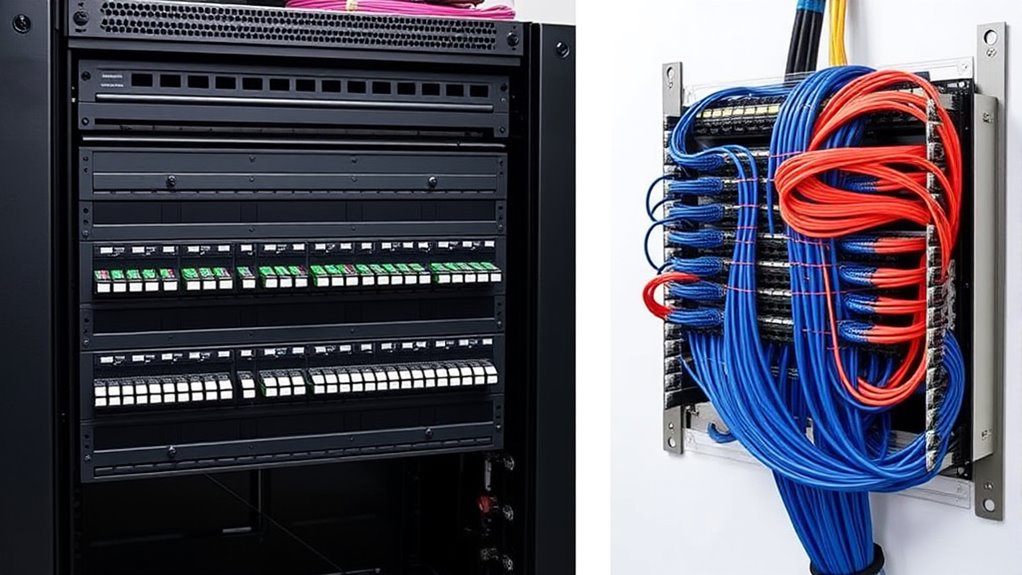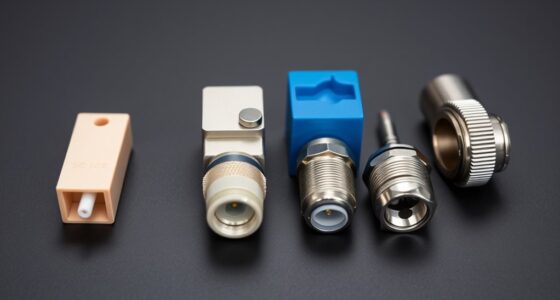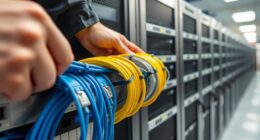When choosing between rack-mount and wall-mount fiber patch panels, consider your space and network scale. Rack-mount panels are ideal for centralized data centers with high port density and room for rack installation, supporting future expansion. Wall-mount options fit smaller setups or limited spaces, offering easy access and quick installation. Think about your current needs and potential growth—continuing can help you decide the best fit for your environment and guarantee seamless connectivity.
Key Takeaways
- Assess available space and environment; rack-mounts suit data centers, wall-mounts fit smaller or limited areas.
- Confirm fiber connector compatibility (LC, SC, ST) with panel types for seamless integration.
- Prioritize cable management features to ensure organization, airflow, and fiber longevity.
- Consider future scalability; rack-mount panels typically support higher density and expansion.
- Choose based on accessibility needs for maintenance, troubleshooting, and quick access in your environment.

Are you unsure how to select the right fiber patch panel for your network? The choice between rack-mount and wall-mount options can seem overwhelming, but understanding your needs makes it easier to decide. The first step is to evaluate your space and your network’s complexity. Rack-mount fiber patch panels are ideal if you’re working with a centralized data center or a large network that requires a significant number of connections. They fit into standard server racks, providing a streamlined, organized setup. Wall-mount panels, on the other hand, suit smaller environments or locations where space is limited. They attach directly to the wall, saving footprint and making cable management more straightforward in tight spaces.
When selecting a fiber patch panel, consider the types of fiber optic connectors you’ll use. Different panels accommodate various connector types, such as LC, SC, or ST, so you want to choose one compatible with your existing or planned fiber infrastructure. This guarantees seamless integration and reduces the need for additional adapters or modifications. For rack-mount panels, you often have the flexibility to install multiple modules, which can support a range of connector types and port densities. Wall-mount panels tend to be more straightforward, typically supporting a fixed set of connectors, but many are still versatile enough for most small-scale applications.
Cable management is another vital factor. Proper cable organization prevents tangling and reduces stress on fibers, prolonging their lifespan and maintaining peak performance. Rack-mount panels generally come with built-in cable management features like cable rings or clips, which help keep fibers neat and easy to access. They also allow for better airflow and cooling within a data center environment. Wall-mount panels might have fewer built-in management options, but you can still add cable ties or clips to keep fibers organized and prevent accidental disconnections. Whichever type you choose, make sure it supports your planned cable runs and provides enough space for future expansion.
Finally, think about ease of access and maintenance. Rack-mounted panels are typically more accessible for large-scale troubleshooting and upgrades, especially when multiple panels are involved. Wall-mounted panels are more accessible in small or remote locations where quick access is necessary. Both options should allow for straightforward connections and disconnections, but your environment and future growth plans will influence which setup works best.
Frequently Asked Questions
How Do I Determine the Right Port Capacity for My Needs?
To determine the right port capacity, start with port planning by evaluating your current and future needs. Estimate capacity based on your network’s growth, considering how many devices you’ll connect now and later. Think about expansion, ensuring the patch panel can handle future upgrades without replacing it. This capacity estimation helps you select a fiber patch panel that offers enough ports, avoiding bottlenecks and ensuring smooth network performance.
What Are the Maintenance Requirements for Different Patch Panel Types?
You need to regularly maintain your patch panel by performing fiber cleaning to keep connections clear and prevent signal issues. Label your patch panel clearly to streamline troubleshooting and maintenance. Check connections periodically, ensure ports are dust-free, and replace any damaged components promptly. Proper maintenance involves inspecting for dirt, dirt, and wear, so staying organized with accurate patch panel labeling and routine fiber cleaning helps extend your patch panel’s lifespan and guarantees peak performance.
Can Rack-Mount Panels Be Adapted for Wall-Mount Use?
Yes, rack-mount panels can be adapted for wall compatibility with the right rack adaptation accessories. Imagine transforming a sturdy, versatile framework into a sleek, space-efficient solution that fits your wall setup. You’ll need compatible mounting brackets or conversion kits designed for wall mounting, ensuring your fiber patch panel stays secure and accessible. With the right tools, you seamlessly blend the robustness of rack-mount panels into your wall-mounted network environment.
What Environmental Factors Affect Fiber Patch Panel Performance?
Environmental factors like temperature fluctuations and humidity levels critically impact your fiber patch panel’s performance. Extreme temperature changes can cause fiber expansion or contraction, leading to signal loss or damage. High humidity promotes moisture buildup, risking corrosion and degradation of connections. To guarantee ideal performance, keep your patch panels in a controlled environment, maintaining stable temperatures and humidity levels, and avoid exposure to moisture or extreme temperatures.
Are There Compatibility Concerns With Existing Networking Equipment?
Yes, compatibility concerns can arise with your existing networking equipment. You should check connector compatibility to guarantee the patch panel’s ports match your connectors, whether LC, SC, or others. Additionally, consider mounting flexibility—rack-mounted panels fit standard racks, while wall-mounted panels offer more versatility for tight spaces. Confirm that the patch panel’s design and specifications align with your current setup to avoid future connectivity issues.
Conclusion
Ultimately, selecting between rack-mount and wall-mount fiber patch panels depends on your space and future needs. Sometimes, it’s almost serendipitous how the right choice aligns with your setup, making maintenance smoother and expansion easier. By understanding your environment’s unique demands, you can confidently pick a panel that not only fits now but also adapts as your network grows. After all, the best choice often feels like a fortunate coincidence, perfectly suited to your evolving connectivity needs.









